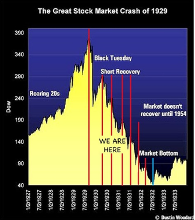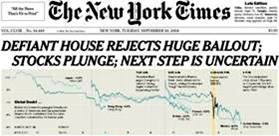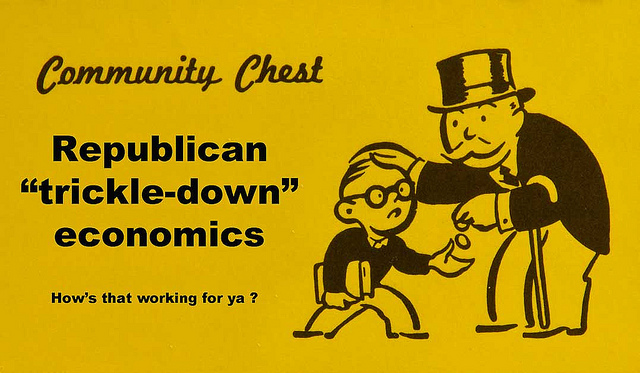The Republican economic plan has been the same since 1980. It is derived from neoliberal (not to be confused with social liberalism) economics, once called laissez-faire economic liberalism, and has evolved from supply-side to “trickle-down” (inspired by the Laffer Curve) or Reaganomics. Convoluted by titles, perhaps, but the common threads have always followed these principles:
1) Lower income taxes for the highest earners because they will expand their businesses and investments.
2) Cut federal spending by eliminating federal agencies.
3) Reduce government regulations on banks and Wall Street, and lowering barriers to produce (supply) goods and services.
Logic follows that consumers will benefit from a greater supply of goods and services at lower prices and the investment and expansion of businesses will increase the demand for employees.
This macroeconomic theory is as old as Merchant Capitalism itself, but it has been the exclusive, adopted economic model in the United States for the past 35 years. Unfortunately, the result has been far from extended prosperity, except for the wealthiest Americans who have seen their holdings increase by nearly 250% (the richest 1% now controlling over 40% of America’s wealth).
Working class wages have remained essentially flat during this time, and as the cost of living has inevitably risen, most Americans have, in effect, received an annual pay cut.
Wealth, it turns out, does not trickle down; it becomes concentrated at the top and the rest of America cannot keep up. The bottom falls out from decreased spending, and more Americans fall into poverty from a systematic inequity of distribution.
It should be noted, however, that this concept was not the sole domain of Republicans; Democrats jumped onto the Trickle Down Train, as well. President Clinton, for one, spent time at the Altar of Alan Greenspan who opposed any regulation on derivatives and preached that the market will always correct itself. Even Greenspan had to admit he was wrong as worthless bundles of trades collapsed Wall Street like a house of cards.
Trickle Down Train, as well. President Clinton, for one, spent time at the Altar of Alan Greenspan who opposed any regulation on derivatives and preached that the market will always correct itself. Even Greenspan had to admit he was wrong as worthless bundles of trades collapsed Wall Street like a house of cards.
It is clear from history that the market will expand and contract somewhat cyclically, but deep recessions and depressions are the result of errors. The Great Depression was the result of a fall in the quantity of money being distributed throughout the system that led to a downfall in production and employment.
 From October 1929 to April 1933, the liquidity of money in our system dropped nearly 40%. When bank deposits dropped by almost half, the wealthy suddenly had too little in their portfolios and a stock sell off began to straighten their positions.
From October 1929 to April 1933, the liquidity of money in our system dropped nearly 40%. When bank deposits dropped by almost half, the wealthy suddenly had too little in their portfolios and a stock sell off began to straighten their positions.
The prices of shares crashed, so did real estate, and demand for goods and production fell off. Corporations, because of an unregulated market (pre-SEC) cooked their books and made, in today’s money, trillions. There was a feeding frenzy and the working American was the fare.
It wasn’t that different in 2008. Wall Street and investors were getting rich beyond measure on sub-prime loans. Bankers knew that the bubble would burst when the housing market leveled and loans would begin to default, but no one stopped it until it was too late because too much money was being made.
housing market leveled and loans would begin to default, but no one stopped it until it was too late because too much money was being made.
The assets became so toxic from bundles of derivatives being tied into better loans, and when the insurers of these loans no longer had the capital to pay on the defaults, well….again, a house of cards.
So…the multi-trillion dollar question is:
How do we recover?
If you make online searches for answers, conservative websites will blame President Obama for all of it (even the collapse that occurred before he came into office) or will accuse his administration of making things worse.
Liberal websites will blame President Bush for every misfire, even “Uggs,” but objective analysis can put the acetate of economic growth and contraction up to the light of history to reveal what is closer to the truth. Former Secretary of Labor, Robert Reich, calls it “The Big Lie.”
That “lie” is that our economic problems are due to a government that’s too large, and that the solution, therefore, is to shrink it.
“The truth,” he says, “is that our economic problems stem from the biggest concentration of income and wealth at the top since 1928, combined with stagnant incomes for most of the rest of us. The result: Americans no longer have the purchasing power to keep the economy going at full capacity. Since the debt bubble burst, most Americans have had to reduce their spending; they need to repay their debts, can’t borrow as before, and must save for retirement.”
The long term solution is to reorganize the economy so the benefits of growth are more widely shared. Reich offers specifics:
1) Make higher education free to families that now can’t afford it.
2) Rehire teachers.
3) Repair and rebuild our infrastructure.
4) Create a new Work Progress Administration to put the unemployed back to work.
5) And rather than marginalize unions, support them, because all workers benefit from collective bargaining for better wages.
__________________________
How do we pay for this? That is a relevant question no matter which side of the aisle you are standing on. “Taxes” are the part of the solution-equation that have become political suicide, even as they are applied to those who have benefitted the most from our current oligarchic financial structure. But, it is within that symbiotic relationship between wealth and Wall Street where the answer lies.
Bernie Sander’s proposal for a Financial Transaction Tax (FTT) could generate 1.5 trillion dollars over the next decade. FTTs are a small fee on stock trades at a rate of 0.1 percent, and trades of most derivative instruments at 0.01%. Speculators would pay a tax on their trades, just like we do when we make purchases. It is an equitable solution
The truth is that taxes go back into our system when they are spent on services, infrastructure, and education, and they create liquidity immediately. By spending on roads, schools, hospitals, bridges, programs and agencies that put people to work, subsidies that help farmers, and new technologies (clean energy, for example) that, in turn, create new businesses, we create jobs.
We have to have serious people in Washington who are willing to be honest, grownup, and take the hits that come with telling the truth.
I suggest we put a consortium of policy wonks, representatives and economists into a room, order pizza, and let them out only when they have come up with a plan for a more stable and equitable economy for all Americans.
I’m really not kidding. Hey…it took “Gamers” only a few days to unlock the puzzle of HIV DNA that had baffled researchers for decades and all they required was the Complete Collection of Dr. Who as incentive.

We can do this and stay on budget!
Who’s with me?

